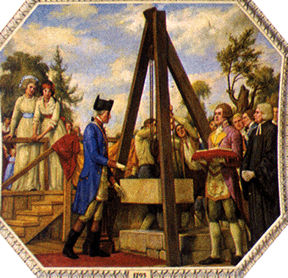washington dc

One of Alexander Hamilton's controversial economic proposals was that the federal government should assume state debts. Since Northern states tended to have larger debts than Southern states, they supported the proposal; while Southern Congressmen opposed it as an unfair burden to the nation. A compromise was finally reached, which allowed the federal government to assume responsibility for state war debts, provided that the national capital be built in the South. The Constitution called for the designation of a "10 mile square" area to serve as the nation's capital. George Washington and three other commissioners chose the specific site for the District of Columbia, on the Potomac River.
In 1790, Benjamin Banneker, an African-American scientist and surveyor, and Andrew Ellicott surveyed the boundaries of the district. Daniel Carroll, one of the signers of the US Constitution, was appointed one of three Commissioners of the District of Columbia, and served from 1791 to 1795. In that capacity, he was responsible for establishing the plans for the district. By January of 1791, Major Pierre Charles L'Enfant, a French-born engineer who had fought in the Revolutionary Army, was appointed to design the city. Working under President Washington's supervision, L'Enfant prepared a grand and ambitious plan for the city, with broad avenues and elegant buildings. Streets were 100 to 110 feet wide, and one avenue was 400 feet wide and about a mile long. Implementing his plan became a difficult venture, as L'Enfant experienced conflicts with local landowners. One such conflict occurred between L'Enfant and Squire Daniel Carroll, the nephew of Commissioner Carroll. According to one source, Squire Carroll wanted to build a new manor house on the site L'Enfant had planned to build a major avenue. This disruption of L'Enfant's plans displeased him so much that he sent a work crew to destroy the partially-completed mansion. This incident, combined with a series of disputes with the District's commissioners, led to President Washington's firing L'Enfant, who took his plans with him. Work on the city continued under Banneker and Ellicott, however, because Banneker had already memorized L'Enfant's plans.
In 1792, the commissioners of the District set up a competition for a design for the nation's Capitol building. They had accepted a plan for the President's Residence from Irish-born architect James Hoban. Thomas Jefferson ran the Capitol competition. The building was to contain the Senate, House of Representatives, the Library of Congress and a number of other offices and chambers. A late entry from William Thornton, a doctor and amateur architect, won the competition, along with a $500 prize. The runner-up, French-born architect Stephen Hallet, was also awarded $500, and was placed in charge of the construction of the Capitol.
As one might guess, Thornton and Hallet came into serious conflict, as Thornton fought to retain his original plan while Hallet gradually changed the design to conform with his ideas. Due to pressure from Thornton, Hallet was dismissed. George Hadfield was hired in 1795. Thornton's criticism of Hadfield led to his dismissal three years later. By 1800, only one wing of the Capitol was completed. Although construction on many buildings was not complete, Washington, D.C.'s offices opened to the public in 1800.
In 1803, Jefferson appointed Benjamin Latrobe, the experienced British-born architect, to supervise the building of the Capitol. He improved the designs of his predecessors in the project and, under his supervision, the Capitol was almost complete by 1811. The American war effort reduced the amount of funding available for building, however, so construction came to something of a standstill.
Washington remained a provincial city in atmosphere for many years, despite its political importance to the nation. It was called a "City of Magnificent Intentions," " a little village in the midst of the woods" and "a capital without a city." The elegant public buildings sharply contrasted with the muddy, unpaved roads; the smelly streets; the hot, sticky summers and the humble boarding houses and shops.
Because of its diplomatic and political importance, however, Washington was a center of much activity. In addition to Congressmen from across the country, visiting foreign dignitaries and American Indian diplomats brought excitement and variety. Washington also supported an active social scene; with dinner parties, hunting games, nearby horse races and a nearby theater.
During the War of 1812, the British invaded Washington and burned many of its buildings. When the reached the Capitol, British Admiral Cockburn was reported to have stood on the House Speaker's chair and asked his troops, "Shall this harbor of Yankee democracy be burned? All for it say 'aye.'" Apparently, the vote was unanimous, and the troops burned everything in sight. In the aftermath of the war, the President's Residence was painted white to cover the scorch marks. Thus, it became known as the "White House." The building itself was rebuilt in October 1817, under architect James Hoban. Latrobe continued work on the Capitol, but resigned in 1817. Charles Bulfinch of Boston took his place in 1818, and remained with the project until the Capitol was completed in 1829.
Even after Washington was restored from the war, however, it looked very different from the Washington we know today. The Capitol did not acquire its Senate and House wings, or its iron dome, until the 1850s and 1860s. The Washington and Jefferson Memorials had not appeared, nor had the Smithsonian Institution or the National Gallery of Art been established. Washington evolved over many years to become a city of cultural prominence, to match its critical political and social role.
 >
>